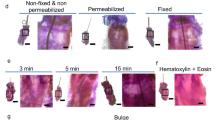Abstract
Scanning electron microscopic studies of human terminal hair follicles of the scalp and eyebrow have previously been limited to the hair shaft. In this study we investigated EDTA-treated extracted whole hair follicles in which most of the basal cell surface of the outer root sheath was well preserved. In the bulge area of scalp follicles there were many knob-like or villous projections. These were located in some specimens on one side of the follicle, while in others they were located around the entire circumference of the follicle. These projections were thought to represent the anchoring points of the branched follicular end of the arrector muscles. Ring-like elevations with groove-like depressions above and below were also observed surrounding the entire follicle. These were thought to represent the track of circumfollicular arrector muscles which depressed the outer root sheath when they repeatedly contracted. Most anagen eyebrow follicles showed morphological variations in the bulge area such as lattice-window-like structures and undulation patterns. In telogen follicles, the bulge became indistinguishable from the clubbed end. The lower end of these telogen follicles showed irregularly shaped bulge areas, but did not show lattice-window-like structures or undulation patterns as observed in anagen follicles. Interestingly, a hole was found in some bulge areas of both anagen and telogen follicles. Serial vertical sections of follicles revealed invaginated areas, which seemed to correspond to the openings seen in whole mounts. In vertical sections of eyebrow follicles some keratinocytes of the outer root sheaths of the bulge area were seen to be melanized to various extents. This phenomen was independent of hair cycle phase.
Similar content being viewed by others
References
Montagna W, Parakkal PF (1974) The pilary apparatus. In: The structure and function of skin. Academic Press, New York, pp 174–275
Hashimoto K, Shibazaki S (1976) Ultrastructural study on differentiation and function of hair. In: Kobori T, Montagna W (eds) Biology and disease of the hair. University of Tokyo Press, Tokyo, pp 23–57
Ito M (1990) The morphology and cell biology of the hair apparatus: recent advances. Acta Med Biol 38: 56–67
Montagna W, Van Scott EJ (1958) The anatomy of the hair follicle. In: The biology of hair growth. Academic Press, New York, pp 39–64
Madsen A (1964) Studies on the ‘bulge’ (Wulst) in superficial basal cell epitheliomas. Arch Dermatol 89: 698–708
Narisawa Y, Hashimoto K, Kohda H (1993) Epithelial skirt and bulge of human facial vellus hair follicles and associated Merkel cell-nerve complex. Arch Dermatol Res 285: 269–277
Narisawa Y, Hashimoto K, Kohda H (1994) Merkel cells of terminal hair follicle of the adult human scalp. J Invest Dermatol 102: 506–510
Cotsarelis G, Sun T-T, Lavker RM (1990) Labeling retaining cells reside in the bulge area of pilosebaceous unit: implications for follicular stem cells, hair cycle, and skin carcinogenesis. Cell 61: 1329–1337
Hashimoto Y (1976) Some observations of hair and hair follicles with a scanning electron microscope. In: Kobori T, Montagna W (eds) Biology and disease of the hair. University of Tokyo Press, Tokyo, pp 59–71
Ito M, Ito K, Hashimoto K (1984) Pathogenesis in trichorrhexis invaginata (bamboo hair). J Invest Dermatol 83: 1–6
Ito M, Hashimoto K, Sakamoto F, Sato Y, Voorhees JJ (1988) Pathogenesis of pili annulati. Arch Dermatol Res 280: 308–318
Hess WH, Seegmiller RE, Gardner JS, Allen JV, Barendregt S (1990) Human hair morphology: a scanning electron microscopy study on a male caucasoid and a computerized classification of regional differences. Scanning Microsc 4: 375–386
Price VH (1990) Structural anomalies of the hair shaft. In: Orfanos CE, Happle R (eds) Hair and hair diseases. Springer, Berlin Heidelberg New York, pp 363–422
Leach EH (1952) The staining of thick sections of skin. Br J Dermatol 64: 183–189
Sanderson KV, Thiede H (1961) The micro-anatomy of normal skin as seen in thick sections. Br J Dermatol 73: 43–56
Ishibashi Y, Tsuru N (1976) Innervation of human hair follicles. In: Toda K, Ishibashi Y, Hori Y, Morikawa F (eds) Biology and diseases of the hair. University of Tokyo Press, Tokyo, pp 73–85
Sato Y (1976) The hair cycle and its control mechanism. In: Toda K, Ishibashi Y, Hori Y, Morikawa F (eds) Biology and diseases of the hair. University of Tokyo Press, Tokyo, pp 3–13
Headington JH (1984) Transverse microscopic anatomy of the human scalp. A basis for a morphometric approach to disorders of the hair follicle. Arch Dermatol 120: 449–456
Halata Z (1990) Specific nerve endings in vellus hair, guard hair, and sinus hair. In: Orfanos CE, Happle R (eds) Hair and hair diseases. Springer, Berlin Heidelberg New York, pp 149–164
Hashimoto K, Ito M, Suzuki Y (1990) Innervation and vasculature of the hair follicle. In: Orfanos CE, Happle R (eds) Hair and hair diseases. Springer, Berlin Heidelberg New York, pp 117–147
Sperling LC (1991) Hair anatomy for the clinician. J Am Acad Dermatol 25: 1–17
Zimmermann KW (1935) Über einige Formverhältnisse der Haarfollikel des Menschen. Z Mikranat Forsch 38: 503–553
Pinkus F (1927) Die normale Anatomie der Haut. In: Jadassohn J (ed) Handbuch der Haut- und Geschlechtskrankheiten, vol 1, part 1. Springer, Berlin New York, pp 1–378
Narisawa Y, Hashimoto K, Kohda H (1993) Human Merkel cells induce the attachment of the arrector pili muscle to the bulge and the formation of perifollicular nerve plexus in the human fetal skin development. Arch Dermatol Res 285: 261–268
Narisawa Y, Kohda H (1993) Arrector pili muscles surround human facial vellus hair follicles. Br J Dermatol 129: 138–139
Pinkus H (1958) Embryology of hair. In: Montagna W, Ellis RA (eds) The biology of hair growth. Academic Press, New York, pp 1–38
Author information
Authors and Affiliations
Rights and permissions
About this article
Cite this article
Narisawa, Y., Hashimoto, K. & Kohda, H. Scanning electron microscopic observations of extracted terminal hair follicles of the adult human scalp and eyebrow with special references to the bulge area. Arch Dermatol Res 287, 599–607 (1995). https://doi.org/10.1007/BF00374083
Received:
Issue Date:
DOI: https://doi.org/10.1007/BF00374083




